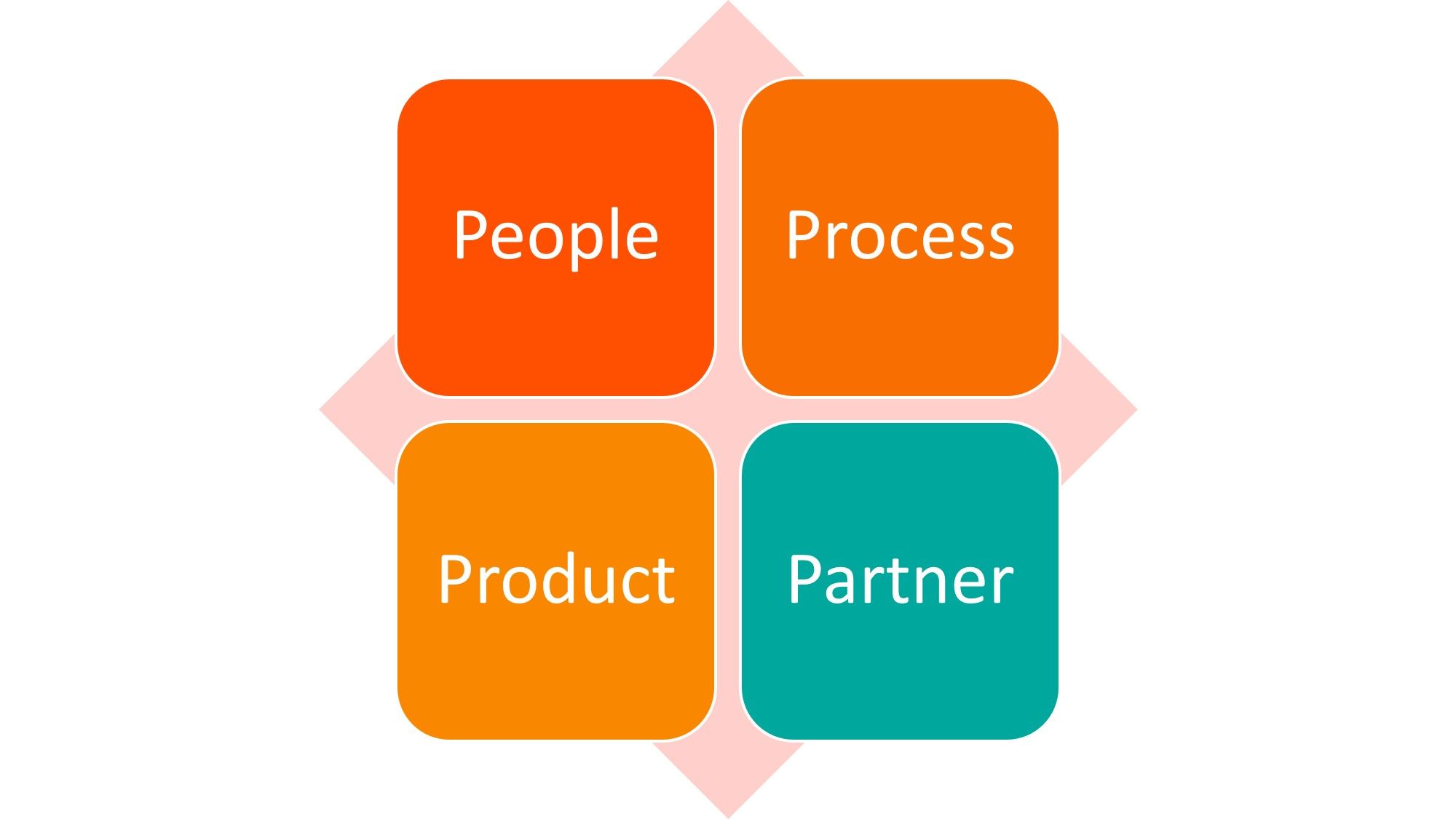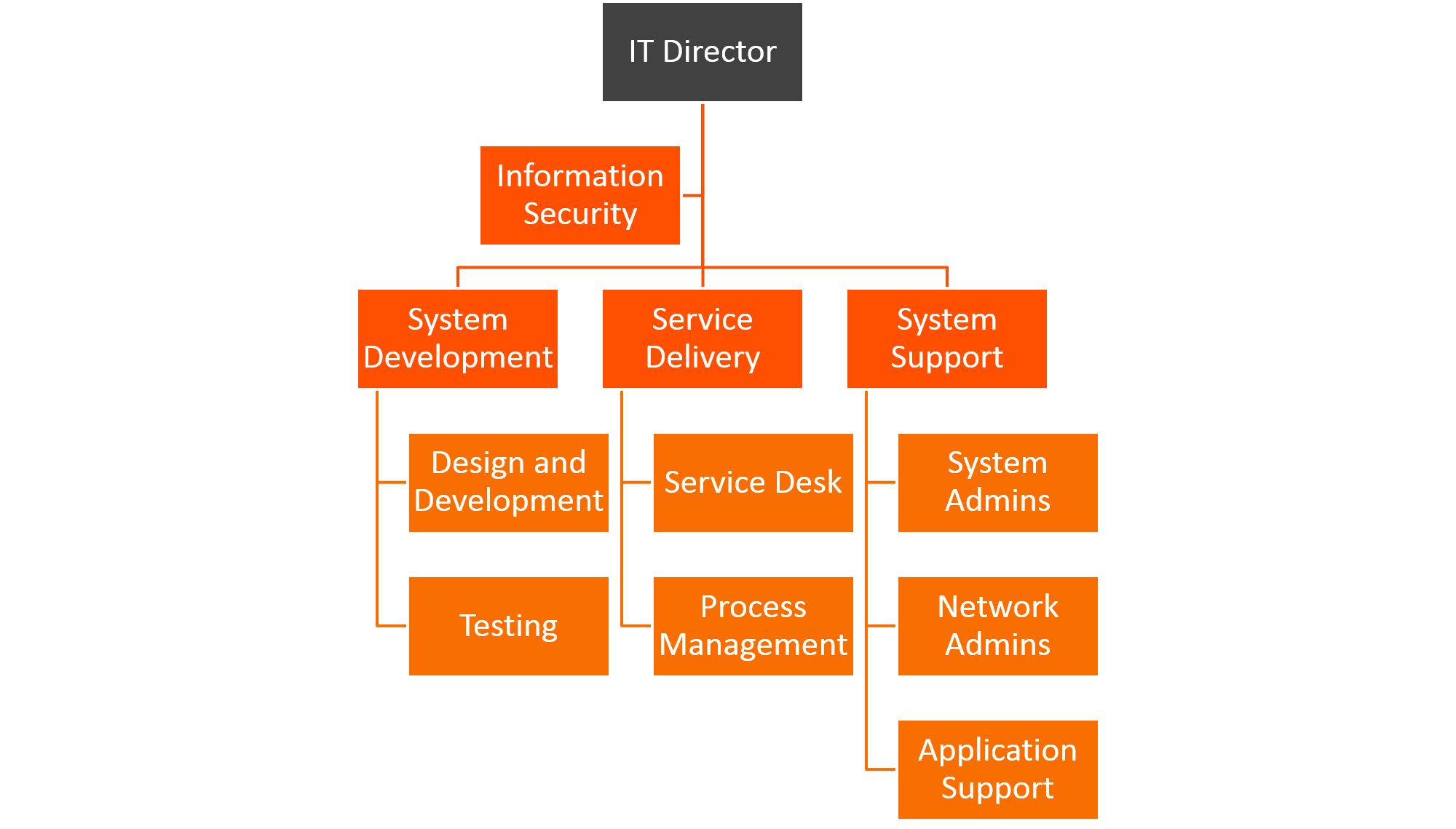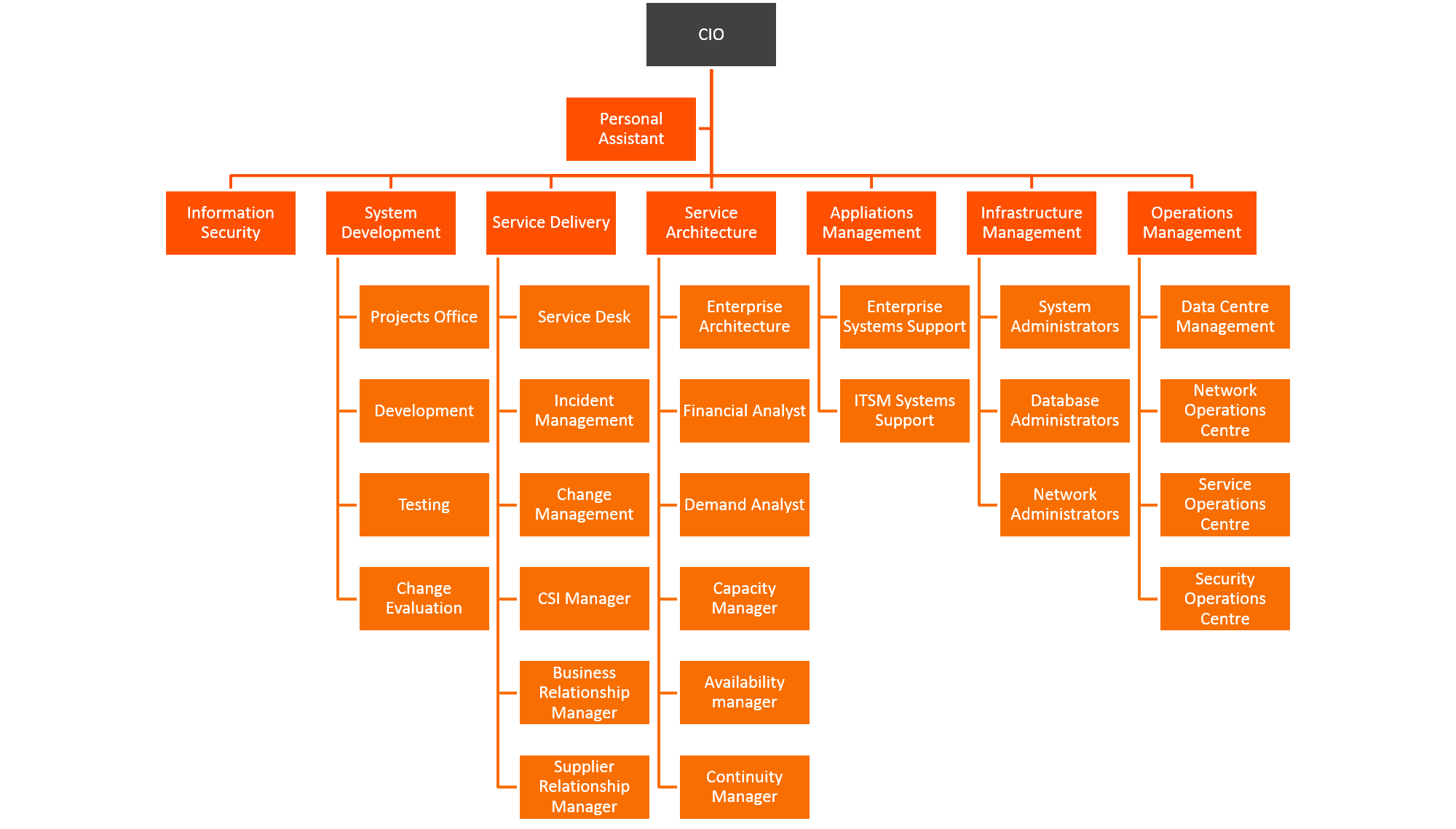IT Service Management roles and responsibilities
No IT Service Management (ITSM) initiative can ever work without people. In fact, the 4 P’s of ITIL® Service Design include People so that should say something about how important it is to structure and organize the people involved in delivery of IT services. People constitute part of the resources and capabilities required to deliver quality IT services to users and customer alike. And since quality service delivery is all about dealing with customers, users and suppliers, the value of instituting proper roles and responsibilities in IT cannot be understated.
A role is a set of responsibilities, activities and authorities granted to a person or team. A role is defined in a process or function. One person or team may have multiple roles – for example, the roles of incident manager and problem manager may be carried out by a single person. Roles are often confused with job titles but it is important to realize that they are not the same. Each organization will define appropriate job titles and job descriptions which suit their needs, and individuals holding these job titles can perform one or more of the required roles.

Download Now: ITIL 4 Best Practice e-Books
These all-new for 2020 ITIL e-books highlight important elements of ITIL 4 best practices. Quickly understand key changes and actionable concepts, written by ITIL 4 contributors.
Organizational structures
There is no single best way to organize, and best practices described in ITIL® need to be tailored to suit individual organizations and situations. Any changes made will need to take into account resource constraints and the size, nature and needs of the business and customers. The starting point for organizational design is strategy, as it sets the direction and guides the criteria for each step of the design process. For strategy to be successful, an organization will need to clearly define the roles and responsibilities required to undertake the processes and activities.
An organization’s age, size, geographical spread and technology use affect its structure. As the organization grows and matures, changes in roles and relationships must be made or problems will arise. This is particularly important for organizations adopting a service orientation, as pressures for efficiency and discipline inevitably lead to greater formalization and complexity. In a small organization multiple roles may be combined under one person. In larger organizations there may be many different people carrying out each of these roles, split by geography, technology or other criteria.
The differences between small and large IT organization can be seen in the table below:
| Small IT Organization | Large IT Organization |
|---|---|
| Roles are combined | Roles are separate |
| Segregation of duties limited | Segregation of duties maximized |
| Generalization of skills | Specialization of skills |
| Less complexity | More complexity |
Example of a small IT department structure
For a small department, multiple roles can be combined as shown. While the numbers are few, the people can be charged with owning multiple services and processes. This structure is simple in nature.

Example of a large IT department structure
For a large department, specialization can take place as dedicated service and process roles can be assigned to individuals and teams where necessary. Care must be taken to ensure a silo mentality does not arise and also complexity managed due to the various interlinkages between multiple units and persons.

Roles in IT Service Management
In ITSM, roles can be categorized or combined in a number of different ways, depending on the organizational context. There are roles that directly interact with people (front facing) while others deal directly with technology (back end). In addition some seem to be a hybrid of the two based on their specialist nature. There are also roles that are directly related to services and others related to processes.
Clear definitions of accountability and responsibility are essential for effective service management. To help with this task the RACI (Responsible – Accountable – Consulted – Informed) model or “authority matrix” is often used within organizations to define the roles and responsibilities in relation to processes and activities. According to ITIL® Service Strategy 2011 publication (pg. 337), the RACI matrix provides a compact, concise, easy method of tracking who does what in each process and it enables decisions to be made with pace and confidence. When using RACI, there is only one person accountable for an activity for a defined scope of applicability. Hence, there must be only one process owner for each process and one service owner for each service.
| R – Responsible | The person or people responsible for correct execution – for getting the job done |
| A – Accountable | The person who has ownership of quality and the end result. Only one person can be accountable for each task |
| C – Consulted | The people who are consulted and whose opinions are sought. They have involvement through input of knowledge and information |
| I – Informed | The people who are kept up to date on progress. They receive information about process execution and quality |
For the sample roles outlined below, some of them are based on ITIL processes while others are based on common IT practices, and the names and combinations may vary depending on the organization. Key thing for every IT organization is to ensure that based on their structure, service offerings and processes, relevant roles are identified, documented and assigned and constantly reviewed. The specific roles within ITIL service management all require specific skills, attributes and competences from the people involved to enable them to work effectively and efficiently. However, whatever the role, it is imperative that the person carrying out that role has the following attributes:
- Awareness of the business priorities, objectives and business drivers
- Awareness of the role IT plays in enabling the business objectives to be met
- Customer service skills
- Awareness of what IT can deliver to the business, including latest capabilities
- The competence, knowledge and information necessary to complete their role
- The ability to use, understand and interpret the best practice, policies and procedures to ensure adherence
For this text, the following sample roles have been defined:
| People Facing Roles | Technology Facing Roles | Other Roles |
|---|---|---|
| Service Desk | Incident Manager | Strategy Analyst |
| Business Relationship Manager | Problem Manager | Finance Analyst |
| Supplier Relationship Manager | Change Manager | Demand Analyst |
| Enterprise Architect | Service Portfolio and Catalogue Manager | |
| Project Manager | Service Delivery Manager | |
| System Developer | ||
| System Support | ||
| Configuration and Deployment Manager | ||
| Quality Assurance and Testing Manager | ||
| IT Security Manager | ||
| IT Service Continuity Manager | ||
| Network and Service Operations Centre Analyst |
People facing roles
- Service Desk
The primary aim of the service desk is to provide a single point of contact between the services being provided and the users. A typical service desk manages incidents and service requests, and also handles communication with the users. Service desk employees execute the first line incident management, access management and request fulfilment processes. According to the ITIL® Service Operations 2011 publication (pg. 158), the responsibilities for this role are typically:- Logging all relevant incident/service request details, allocating categorization and prioritization codes
- Providing first-line investigation and diagnosis
- Resolving incidents/service requests when first contacted whenever possible
- Escalating incidents/service requests that they cannot resolve within agreed timescales
- Keeping users informed of progress
- Closing all resolved incidents, requests and other calls
- Conducting customer/user satisfaction call-backs/surveys as agreed
- Communication with users – keeping them informed of incident progress, notifying them of impending changes or agreed outages, etc.
- Updating the CMS under the direction and approval of service asset and configuration management if so agreed
- Business Relationship Manager
This role can wear several hats including account manager and service level manager. The activities handled include those under the business relationship management and service level management processes. According to the ITIL® Service Strategy (pg. 334) and Service Design (pg. 260-261) 2011 publications, the responsibilities for this role are typically:- Establishing and maintaining a constructive relationship between the service provider and the customer based on understanding the customer and their business drivers
- Identifying changes to the customer environment and technology trends that could potentially impact the type, level or utilization of services provided
- Establishing and articulating business requirements for new services or changes to existing services
- Mediating in cases where there are conflicting requirements for services from different business units
- Ensuring that the current and future service level requirements (service warranty) of customers are identified, understood and documented in SLA (Service Level Agreement) and service level requirements (SLR) documents
- Negotiating and agreeing levels of service to be delivered with the customer (either internal or external); formally documenting these levels of service in SLAs
- Negotiating and agreeing OLAs (Operational Level Agreements) and, in some cases, other SLAs and agreements that underpin the SLAs with the customers of the service
- Assisting with the production and maintenance of an accurate service portfolio, service catalogue, application portfolio and the corresponding maintenance procedures
- Ensuring that targets agreed within underpinning contracts are aligned with SLA and SLR targets
- Ensuring that service reports are produced for each customer service and that breaches of SLA targets are highlighted, investigated and actions taken to prevent their recurrence
- Ensuring that service performance reviews are scheduled, carried out with customers regularly and documented, with agreed actions progressed
- Ensuring that improvement initiatives identified in service reviews are acted on and progress reports are provided to customers
- Reviewing service scope, SLAs, OLAs and other agreements on a regular basis, ideally at least annually
- Ensuring that all changes are assessed for their impact on service levels, including SLAs, OLAs and underpinning contracts, including attendance at change advisory board (CAB) meetings if appropriate
- Identifying all customers and other key stakeholders to involve in SLR, SLA and OLA negotiations
- Managing customer complaints including their recording, management, escalation (where necessary) and resolution
- Measuring, recording, analysing and improving customer satisfaction
- Supplier Relationship Manager
This role is responsible for being the interface between the IT department and third party suppliers of assets and services, who are external to the organization. This role may exist in a procurement or supply chain function and be seconded to IT. According to the ITIL® Service Design 2011 publication (pg. 266-267), the responsibilities for this role are typically:- Coordinating interfaces between supplier management and other processes, especially service level management and corporate vendor management and/or procurement processes
- Providing assistance in the development and review of SLAs, contracts, agreements or any other documents for third-party suppliers
- Ensuring that value for money is obtained from all IT suppliers and contracts
- Ensuring that all IT supplier processes are consistent and interface with all corporate supplier strategies, processes and standard terms and conditions
- Maintaining and reviewing a supplier and contract management information system
- Reviewing and making risk assessments of all suppliers and contracts on a regular basis
- Ensuring that any underpinning contracts, agreements or SLAs developed are aligned with those of the business
- Ensuring that all supporting services are scoped and documented and that interfaces and dependencies between suppliers, supporting services and supplier processes are agreed and documented
- Ensuring that all roles and relationships between lead and any sub-contracted suppliers are documented, maintained and subject to contractual agreement
- Performing contract or SLA reviews at least annually, and ensuring that all contracts are consistent with organizational requirements and standard terms and conditions wherever possible
- Maintaining a process for dealing with contractual disputes, and ensuring that any disputes are dealt with in an efficient and effective manner
- Monitoring, reporting and regularly reviewing supplier performance against targets, identifying improvement actions as appropriate and ensuring these actions are implemented
- Ensuring changes are assessed for their impact on suppliers, supporting services and contracts and attending CAB meetings when appropriate
- Coordinating and supporting all individual IT supplier and contract managers, ensuring that each supplier/contract has a nominated owner within the service provider organization
Technology facing roles
- Incident Manager
This role is responsible for overall coordination of the incident management process, in particular whenever there are major incidents. According to the ITIL® Service Operations 2011 publication (pg. 194-195), the responsibilities for this role are typically:- Planning and managing support for incident management tools and processes
- Coordinating interfaces between incident management and other service management processes
- Driving the efficiency and effectiveness of the incident management process
- Producing management information
- Managing the work of incident support staff (first- and second-line)
- Monitoring the effectiveness of incident management and making recommendations for improvement
- Developing and maintaining the incident management systems
- Managing major incidents
- Developing and maintaining the incident management process and procedures
- Problem Manager
Once incidents are solved, the ball is passed to the problem manager to coordinate investigation into the root cause, identifying workarounds and following up for permanent resolution. According to the ITIL® Service Operations 2011 publication (pg. 195-196), the responsibilities for this role are typically:- Reviewing incident data to analyse assigned problems
- Analysing problems for correct prioritization and classification
- Investigating assigned problems through to resolution or root cause
- Coordinating actions of others as necessary to assist with analysis and resolution actions for problems and known errors
- Raising RFCs to resolve problems
- Monitoring progress on the resolution of known errors and advising incident management staff on the best available workaround for incidents
- Updating the KEDB with new or updated known errors and workarounds
- Assisting with the handling of major incidents and identifying their root causes
- Change Manager
During service transition, this key role exists to coordinate the review and approval of planned changes to the IT infrastructure and services. According to the ITIL® Service Transition 2011 publication, the responsibilities for this role are typically:- Planning and managing support for change management tools and processes
- Maintaining the change schedule and projected service outage
- Coordinating interfaces between change management and other processes
- Reviewing specific categories of RFC
- Planning, scheduling, managing and chairing CAB meetings
- Formally authorizing changes at agreed points in the change lifecycle
- Participating in the change review before changes are closed
- Project Manager
In ITSM, the project manager’s role is to define and maintain the service provider’s project management standards and to provide overall resources and management of IT projects. This role is actively involved in the work of the service design as well as the service transition stages of the service lifecycle, and would manage the design coordination as well as transition planning and support processes. According to the ITIL® Service Design (259-260) and Service Transition (pg. 227) 2011 publications, the responsibilities for this role are typically:- Coordinating interfaces between design coordination, service transition planning and reporting and other processes
- Ensuring the consistent design of appropriate services, service management information systems, architectures, technology, processes, information and metrics to meet current and evolving business outcomes and requirements
- Coordinating all design activities across projects, changes, suppliers and support teams, and managing schedules, resources and conflicts where required
- Planning and coordinating the resources and capabilities required to design new or changed services
- Ensuring that appropriate service designs and/or SDPs are produced and that they are handed over to service transition as agreed
- Managing the quality criteria, requirements and handover points between the service design stage and service strategy and service transition
- Ensuring that all service models and service solution designs conform to strategic, architectural, governance and other corporate requirements
- Improving the effectiveness and efficiency of service design activities and processes
- Coordinating service transition activities across projects, suppliers and service teams
- Ensuring that the final delivery of each service transition meets the agreed customer and stakeholder requirements specified in the service design package
- Enterprise Architect
An IT designer/architect is responsible for the overall coordination and design of the required technology. According to the ITIL® Service Design 2011 publication (pg. 268-269), the responsibilities for this role are typically:- Producing a process map of all of the processes and their high-level interfaces, to ensure integration, consistency and continuity across all processes
- Designing secure and resilient technology architectures that meet all the current and anticipated future IT requirements of the organization
- Ensuring that the design of all processes, roles, responsibilities and documentation is regularly reviewed and audited for efficiency, effectiveness and compliance
- Designing measurement methods and metrics to support the continual improvement of service provision and all supporting processes
- Producing and keep up to date all IT design, architectural, policy and specification documentation
- Producing and maintaining all aspects of IT specification, including the overall designs, architectures, topologies and configurations of the infrastructure, environment, applications and data, and the design documentation of all IT systems
- Recommending proactive, innovative IT solutions for the improvement of IT design and operation whenever and wherever possible
- Translating logical designs into physical designs, taking account of business requirements, target environments, processes, performance requirements, existing systems and services, and any potential safety-related aspects
- Creating and maintaining IT design policies, philosophies and criteria, covering all areas including connectivity, capacity, interfaces, security, resilience, recovery, access and remote access, and ensuring that all new services meet their service levels and targets
- Working with capacity management and reviewing IT traffic volumes and requirements, identifying trends in traffic flows and levels of service
- Proposing design enhancements to IT infrastructure, capacity changes, continuity, backup and recovery arrangements, as required, and being aware of operational requirements, especially in terms of service levels, availability, response times, security and repair times
- Reviewing IT costs against external service providers, new developments and new services, initiating proposals to change IT design where appropriate cost reductions and benefits can be achieved, in consultation with financial management for IT services
- Providing advice and guidance to management on the design and planning phases of IT systems, to ensure that requirements (particularly capacity, recovery, performance and security needs) are reflected in the overall specifications
- Providing advice and guidance to all areas of IT and business management, analysts, planners, designers and developers on all aspects of IT design and technology
- Interfacing with designers and planners from external suppliers and service providers, ensuring all external IT services are designed to meet their agreed service levels and targets
- Playing a major role in the selection of any new IT infrastructure or technology solutions
- Assuming technical responsibility for IT standards, policy and design for all significant projects or major application areas, assisting with the impact assessment and evaluation of major new IT design options
- Taking full responsibility for the design aspects of all stages of the lifecycle of IT systems, including investigation, analysis, specification, design, development, construction, testing, maintenance, upgrade, transition, operation and improvement
- Constructing, interpreting and monitoring test plans to verify correct operation of completed systems against their design objectives
- Where required, assessing changes for their conformance to the design principles, including attendance at CAB meetings if appropriate
- Systems Developer
When it comes to software development and systems configuration, the system developer role comes into play. According to the ITIL® Service Transition 2011 publication (pg. 230-231), the responsibilities for this role are typically:- Helping to design the release package, during the service design stage of the service lifecycle, in conjunction with personnel from other teams and functions
- Establishing the final release configuration, including knowledge, information, hardware, software and infrastructure
- Building the release
- Testing the release prior to independent testing
- Establishing and reporting outstanding known errors and workarounds
- Providing input to support change authorization for check-in of the release to the DML (definitive media library)
- Providing early life support for the deployed service
- Systems Support
This role performs the operational activities which ITIL defines should be carried out by the technical management and application management functions, being the second line support role. According to the ITIL® Service Operation 2011 publication (pg. 201-203), the responsibilities for this role are typically:- Participating in the design and development of new services
- Participating in projects, not only during service design and service transition, but also for CSI or operational projects
- Assessing risk, identifying critical service and system dependencies and defining and implementing countermeasures
- Designing and performing tests for the functionality, performance and manageability of IT services to support service transition activities
- Participating in resolution of incidents and problems
- Providing information for, and operationally maintaining, the CMS (Configuration Management System) and its data
- Attending CAB meetings
- Supporting service deployment activities
- Ensuring that all system and operating documentation and knowledge is up to date and properly utilized
- Configuration and Deployment Manager
This role covers the ITIL® processes of Service Asset and Configuration Management (SACM) as well as Release and Deployment Management. According to the ITIL® Service Transition 2011 publication (pg. 229-231), the responsibilities for this role are typically:- Accountable to the organization for stewardship of fixed assets of the organization that are under the control of IT
- Defining and agreeing the service assets that will be treated as configuration items
- Ensuring that configuration data is available when and where it is needed to support other service management processes
- Planning and managing support for SACM tools and processes
- Coordinating interfaces between SACM and other processes
- Defining the structure of the configuration management system, including CI types, naming conventions, required and optional attributes and relationships
- Training staff in SACM principles, processes and procedures
- Performing configuration audits
- Planning and coordinating all resources needed to build, test and deploy each release
- Planning and managing support for release and deployment management tools and processes
- Ensuring that change authorization is provided before any activity that requires this, for example before a release is checked in to the definitive media library (DML) and before it is deployed to a live environment
- Coordinating interfaces between release and deployment management and other processes, especially change management, SACM, and service validation and testing
- Quality Assurance and Testing Manager
Once development and configuration takes place, it’s up to the Quality Assurance and Testing Manager role to manage the testing and validation of the new services and infrastructure based on the business requirements. According to the ITIL® Service Transition 2011 publication (pg. 231-232), the responsibilities for this role are typically:- Helping to design and plan testing conditions, test scripts and test data sets during the service design stage of the service lifecycle, to ensure appropriate and adequate coverage and control
- Allocating and overseeing test resources, ensuring that test policies are adhered to
- Verifying tests conducted by release and deployment management or other teams
- Managing test environment requirements
- Planning and managing support for service testing and validation tools and processes
- Providing management reporting on test progress, test outcomes, success rates, issues and risks
- Conducting tests as defined in the test plans and designs, and documented in the service design package
- Recording, analysing, diagnosing, reporting and managing test events, incidents, problems and retest dependent on agreed criteria
- Administering test assets and components
- Building, delivering and maintaining required test environments
- Information Security Manager
In today’s age securing the confidentiality, integrity and availability of information assets has become a mandatory role for any IT organization. According to the ITIL® Service Design 2011 publication (pg. 265-266), the responsibilities for this role are typically:- Developing and maintaining the information security policy and a supporting set of specific policies, ensuring appropriate authorization, commitment and endorsement from senior IT and business management
- Communicating and publicizing the information security policy to all appropriate parties
- Ensuring that the information security policy is enforced and adhered to
- Identifying and classifying IT and information assets (configuration items) and the level of control and protection required
- Assisting with business impact analyses
- Performing security risk assessment and risk management in conjunction with availability and IT service continuity management
- Designing security controls and developing security plans
- Developing and documenting procedures for operating and maintaining security controls
- Monitoring and managing all security breaches and handling security incidents, taking remedial action to prevent recurrence wherever possible
- Reporting, analysing and reducing the impact and volumes of all security incidents in conjunction with problem management
- Promoting education and awareness of security
- Maintaining a set of security controls and documentation, and regularly reviewing and auditing all security controls and procedures
- IT Service Continuity Manager
In IT, this role can also be called business continuity manager, if the main organization has not implemented a business continuity framework. This role ensures that IT is prepared for any eventuality that could significantly impact running of business services including disasters. According to the ITIL® Service Design 2011 publication (pg. 264-265), the responsibilities for this role are typically:- Performing business impact analyses for all existing and new services
- Implementing and maintaining the IT service continuity management process, in accordance with the overall requirements of the organization’s business continuity management process, and representing the IT services function within the business continuity management process
- Ensuring that all IT service continuity management plans, risks and activities underpin and align with all business continuity management plans, risks and activities, and are capable of meeting the agreed and documented targets under any circumstances
- Performing risk assessment and risk management to prevent disasters where cost justifiable and where practical
- Ensuring that all IT service areas are prepared and able to respond to an invocation of the continuity plans
- Maintaining a comprehensive IT testing schedule, including testing all continuity plans in line with business requirements and after every major business change
- Undertaking quality reviews of all procedures and ensuring that these are incorporated into the testing schedule
- Communicating and maintaining awareness of IT service continuity management objectives within the business areas supported and IT service areas
- Undertaking regular reviews, at least annually, of the continuity plans with the business areas to ensure that they accurately reflect the business needs
- Negotiating and managing contracts with providers of third-party recovery services
- Assessing changes for their impact on service continuity and continuity plans
- Attending CAB meetings when appropriate
- Developing and maintaining the organization’s continuity strategy
- Assessing potential service continuity issues and invoking the service continuity plan if necessary
- Managing the service continuity plan while it is in operation, including fail-over to a secondary location and restoration to the primary location
- Performing post-mortem reviews of service continuity tests and invocations, and instigating corrective actions where required
- Developing and managing the IT service continuity management plans to ensure that, at all times, the recovery objectives of the business can be achieved
- Network and Service Operations Centre Analyst
Continuous monitoring of IT infrastructure and services has become a daily job for IT departments who provide critical services. According to the ITIL® Service Operation 2011 publication (pg. 202), the responsibilities for this role typically include:- Console management/operations bridge management
- Job scheduling, or the management of routine batch jobs or scripts
- Backup and restore on behalf of all technical and application management teams and departments and often on behalf of users
- Print and output management for the collation and distribution of all centralized printing or electronic output
- Performance of maintenance activities on behalf of technical or application management teams or departments
- Management of the physical IT environment, typically a data centre or server rooms and recovery sites together with all the power and cooling equipment
Other roles
- Strategy Analyst
No IT organization will function effectively without a strategy that is aligned to the one of the corporate organization. According to the ITIL® Service Strategy 2011 publication (pg. 332), the responsibilities for this role typically include:- Formulating, documenting and maintaining the organization’s overall IT strategy, so as to best underpin the business strategy
- Assisting in informing, publicizing and marketing of the key aspects of the IT strategy so that all customers, potential customers, staff members, suppliers and other relevant groups are aware of the IT strategy and how it will be taken forward
- Being responsible to the IT steering group for the successful implementation and operation of the IT strategy
- Reviewing the operation and performance of the IT strategy and makes any necessary changes or adjustments to the IT strategic plans or the way they are implemented or operated
- Planning and managing support for strategy management tools and processes
- Coordinating interfaces between strategy management for IT services and other processes
- Finance Analyst
This role, mostly found in a Finance Department or can be seconded to IT, is responsible for managing the accounting, budgeting and charging activities relating to IT services and infrastructure. According to the ITIL® Service Strategy 2011 publication (pg.332-335), this role has typically the following responsibilities:- Compiling and formulating the annual IT budgets and submits them for scrutiny and approval by the IT steering group
- Managing the IT budgets on a daily, monthly and annual basis, initiating corrective actions to balance income and expenditure in line with the budgets
- Producing regular statements of accounts for management information and to allow relevant managers to manage their own areas of the budgets
- Formulating and managing any recharging systems for IT customers
- Examining and reporting on value-for-money of all major activities, projects and proposed expenditure items within IT
- Demand Analyst
This strategic role is critical when it comes to understanding, anticipating and influencing customer demand for services. It usually works with roles handling capacity management to ensure that IT has capacity to meet this demand. According to the ITIL® Service Strategy 2011 publication (pg. 335), the responsibilities for this role are typically:- Identifying and analyzing patterns of business activity to understand the levels of demand that will be placed on a service
- Defining and analyzing user profiles to understand the typical profiles of demand for services from different types of user
- Helping design services to meet the patterns of business activity and the ability to meet business outcomes
- Ensuring that adequate resources are available at the appropriate levels of capacity to meet the demand for services, thus maintaining a balance between the cost of service and the value that it achieves
- Anticipating and preventing or managing situations where demand for a service exceeds the capacity to deliver it
- Gearing the utilization of resources that deliver services to meet the fluctuating levels of demand for those services
- Service Portfolio and Catalogue Manager
This role would be responsible for managing the service portfolio which consists of the planned, live and retired services. The live services are usually documented in a service catalogue. This role cuts across the Service Portfolio Management and Service Catalogue Management processes. According to the ITIL® Service Strategy (pg. 333) and Service Design (pg. 260) 2011 publications, the responsibilities of this role typically include:- Managing and maintaining the organization’s service portfolio
- Managing the surrounding processes for keeping the portfolio attractive to customers and up to date
- Marketing the portfolio, and in particular the service catalogue, so that customers and potential customers are aware of the services available
- Helping formulate service packages and associated options, so that services can be combined in logical groupings to produce products that can be marketed, sold and consumed to best meet customers’ needs
- Ensuring that all operational services and all services being prepared for operational running are recorded within the service catalogue
- Ensuring that all the information within the service catalogue is accurate and up to date
- Ensuring that appropriate views of the service catalogue are maintained and made available to those for whom they are targeted
- Ensuring that all the information within the service catalogue is consistent with the information within the service portfolio
- Ensuring that the information within the service catalogue is adequately protected and backed up
- Service Delivery Manager
This role would cover the ITIL® processes of Knowledge Management and Continual Service Improvement (CSI). According to the ITIL® Service Transition (pg. 233) and Continual Service Improvement (pg. 132-133) 2011 publications, the responsibilities for this role are typically:- Ensuring that all knowledge items are made accessible to those who need them in an efficient and effective manner
- Planning and managing support for knowledge management tools and processes
- Encouraging people throughout the service provider to contribute knowledge to the service knowledge management system (SKMS)
- Acting as an adviser to business and IT personnel on knowledge management matters, including policy decisions on storage, value, worth etc.
- Identifying, controlling and storing any information deemed to be pertinent to the services provided that is not available by other means
- Maintaining controlled knowledge items to ensure that they are current, relevant and valid
- Monitoring publicity regarding the knowledge information to ensure that information is not duplicated and is recognized as a central source of information etc.
- Setting direction and providing a framework through which improvement objectives can be delivered
- Communicating the vision of CSI across the IT organization
- Designing the CSI register and associated activities
- Defining and creating reports on CSI critical success factors (CSFs), key performance indicators (KPIs) and CSI activity metrics
- Ensuring that CSI activities are coordinated throughout the service lifecycle







